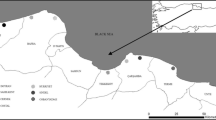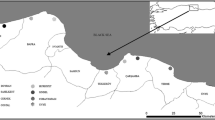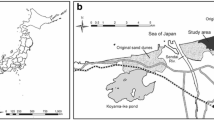Abstract
Plant co-occurence patterns were studied in coastal dunes in Central Black Sea Region of Turkey (North of Turkey) by the help of the checkerboard score (C-score), and the checkerboard score for abundance data (CA-score) along climatic and local gradients. There were significant differences along the local and climatic gradients with respect to both standardised C- and CA-scores. Standardised C-scores were found to be significantly different along sea–inland gradient except for fixed dune zone, while standardised CA-scores were significantly different in embryonic and main dune zones. Our results were supported HBR (humped-back relationships) hypothesis in studied coastal dunes because standardised scores were usually found to be >0. In other words, segregation was prevailed in studied species rather than aggregation.






Similar content being viewed by others
References
Acosta A, Blasi C, Stanisci A (2000) Spatial connectivity and boundary patterns in coastal dune vegetation in the Circeo National Park, Central Italy. J Veg Sci 11(1):149–154
Agır SU, Kutbay HG, Surmen B (2014) The classification of coastal dune vegetation in Central Black Sea Region of Turkey by numerical methods and EU habitat types. Rend Fis Acc Lincei 25(4):453–460
Agır SU, Kutbay HG, Surmen B (2016) Plant diversity along coastal dunes of the Black Sea (North of Turkey). Rend Fis Acc Lincei. doi:10.1007/s12210-015-0497-z
Armas C, Pugnaire FI (2009) Ontogenetic shifts in interactions of two dominant shrub species in a semi-arid coastal sand dune system. J Veg Sci 20:535–546
Bertness M, Callaway RM (1994) Positive interactions in communities. Trend Ecol Evol 9:191–193
Bowker MA, Soliveres S, Maestre FT (2010) Competition increases with abiotic stress and regulates the diversity of biological soil crusts. J Ecol 98:551–560
Cakan H, Yilmaz KT, Alphan A, Unlukaplan Y (2011) The classification and assessment of vegetation for monitoring coastal sand dune succession: the case of Tuzla in Adana, Turkey. Turk J Bot 35(6):697–711
Carboni M, Santoro R, Acosta ATR (2011) Dealing with scarce data to understand how environmental gradients and propagule pressure shape fine-scale alien distribution patterns on coastal dunes. J Veg Sci 22:751–765
Castanho CT, Oliveira AA, Prado PI (2012) The importance of plant life form on spatial associations along a subtropical coastal dune gradient. J Veg Sci 23:952–961
Castanho CT, Jortie CJ, Zaitchik B, Prado PI (2015) A meta-analysis of plant facilitation in coastal dune systems: responses, localities, and research gaps. PeerJ 3:e768
Costa JC, Arsenio P, Monteiro-Henriques T, Neto C, Pereira E, Almeida T, Izco J (2009) Finding the boundary between Eurosiberian and Mediterranean salt marshes. J Coast Res 56:1340–1344
Deegan BM, Harrington TJ (2004) The distribution and ecology of Schoenoplectus triqueter in the Shannon Estuary. In: Biology and environment: proceedings of the Royal Irish Academy
Ellenberg H, Mueller-Dombois D (1967) A key to Raunkiaer plant life forms with revised subdivisions. Ber Geobot Inst eidg tech Hochschule Rubel 37:56–73
Forey E, Lortie C, Richard M (2009) Spatial patterns of association at local and regional scales in coastal sand dune. J Veg Sci 20:916–925
Gotelli NJ (2000) Null model analysis of species co-occurrence patterns. Ecology 81:2606–2621
Gotelli NJ, Entsminger GL (2004) ECOSIM: null models software for ecology (version 7). http://garyentsminger.com/ecosim/index.htm
Gotelli NJ, McCabe DJ (2002) Species co-occurrence: a meta analysis of J. M. Diamond’s assembly rules model. Ecology 83:2091–2096
Gotzenberger L, de Bello F, Brathen KA, Davison J, Dubuis A, Guisan A, Leps J, Lindborg R, Moora M, Partel M, Pellisier L, Pottier J, Vittoz P, Zobel K, Zobel M (2012) Ecological assembly rules in plant communities—approaches, patterns and prospects. Biol Rev 87:111–127
Grime JP (1973) Competitive exclusion in herbaceous vegetation. Nature 242:344–347
Hill MO (1979) TWINSPAN: a FORTRAN program for arranging multivariate data in an ordered two-way table by classification of the individuals and attributes, vol iv. Section of Ecology and Systematics, Cornell University, Ithaca
Holmgren M, Scheffer M (2010) Strong facilitation in mild environments: the stress gradient hypothesis revisited. J Ecol 98:1269–1275
Honrado J, Vicente J, Lomba A, Alves P, Macedo JA, Henriques R, Granja H, Caldas FB (2010) Fine-scale patterns of vegetation assembly in the monitoring of changes in coastal sand-dune landscapes. Web Ecol 10:1–14
IBM Corporation Released (2012) IBM SPSS statistics for windows, version 21.0. IBM Corp, Armonk
Isermann M (2011) Patterns in species diversity during succession of coastal dunes. J Coast Res 27(4):661–671
Lane C, Wright SJ, Roncal J, Maschinski J (2008) Characterizing environmental gradient and their influence on vegetation zonation in a subtropical coastal sand dune system. J Coast Res 24(4C):213–224
Lomba A, Alves P, Honrado J (2008) Endemic sand dune vegetation of the Northwest Iberian Peninsula: diversity, dynamics, and significance for bioindication and monitoring of coastal landscapes. J Coast Res 24:113–121
Macedo JA, Alves P, Lomba A, Vicente J, Henriques R, Granja H, Honrado J (2010) On the interest of plant functional classifications to study community-level effects of increased disturbance on coastal dune vegetation. Acta Bot Gall 157:305–315
Maestre F, Callaway MF, Valladares F, Lortie CJ (2009) Refining the stress-gradient hypothesis for competition and facilitation in plant communities. J Ecol 97:199–205
Maltez-Mouro S, Maestre FT, Freitas H (2010) Co-occurence patterns and abiotic stress in sand-dune communities: their relationship varies with spatial scale and the stress-estimator. Acta Oecol 36:80–84
Maun MA (2009) The biology of coastal sand dunes. Oxford University Press, Oxford
Michalet R, Brooker RW, Cavieres LA, Kikvidze Z, Lortie CJ, Pugnaire FI, Valiente-Banuet A, Callaway RM (2006) Do biotic interactions shape both sides of the humped-back model of species richness in plant communities? Ecol Lett 9:767–773
Miller TE (2015) Effects of disturbance on vegetation by sand accretion and erosion across coastal dune habitats on a barrier island. AoB Plants 7:plv003
Mueller-Dombois D, Ellenberg H (1974) Aims and methods of vegetation ecology. Wiley, New York
Prisco I, Carboni M, Acosta ATR (2013) The fate of threatened coastal dune habitats in Italy under climate change scenarios. PLoS One 8(7):1–14
Rey PJ, Alcantara JM, Manzaneda AJ, Sánchez-Lafuente AM (2016) Facilitation contributes to Mediterranean woody plant diversity but does not shape the diversity–productivity relationship along aridity gradients. New Phytol 211:464–476
Ruocco M, Bertoni D, Sarti G, Ciccarelli D (2014) Mediterranean coastal dune systems: which abiotic factors have the most influence on plant communities? Estuar Coast Shelf Sci 149:213–222
Santoro R, Jucker T, Carboni M, Acosta ATR (2012) Patterns of plant community assembly in invaded and non-invaded communities along a natural environmental gradient. J Veg Sci 23:483–494
Ulrich W, Gotelli N (2010) Null model analysis of species associations using abundance data. Ecology 91:3384–3397
Vaz AS, Macedo JA, Alves P, Honrado JP, Lomba A (2015) Plant species segregation in dune ecosystems emphasises competition and species sorting over facilitation. Plant Ecol Divers 8(1):113–125
Waugh JM, Aarssen LW (2011) Spatial indicators of plant community assembly from a 453 year sand-dune chronosequence. Plant Ecol Divers 4:153–165
Yalcin E, Kilinc M, Kutbay HG, Bilgin A, Korkmaz H (2011) Floristic properties of lowland meadows in the Central Black Sea Region of Turkey. Eur J Biosci 5:54–63
Author information
Authors and Affiliations
Corresponding author
Rights and permissions
About this article
Cite this article
Agır, S.U., Kutbay, H.G. & Surmen, B. Species co-occurence in coastal dunes in North of Turkey. Rend. Fis. Acc. Lincei 27, 729–736 (2016). https://doi.org/10.1007/s12210-016-0563-1
Received:
Accepted:
Published:
Issue Date:
DOI: https://doi.org/10.1007/s12210-016-0563-1




